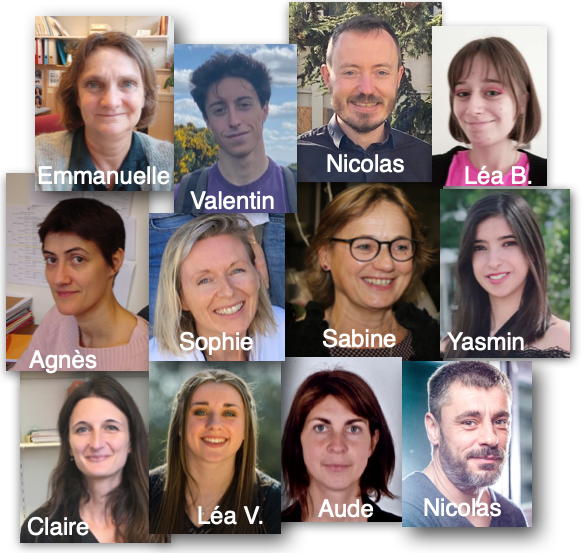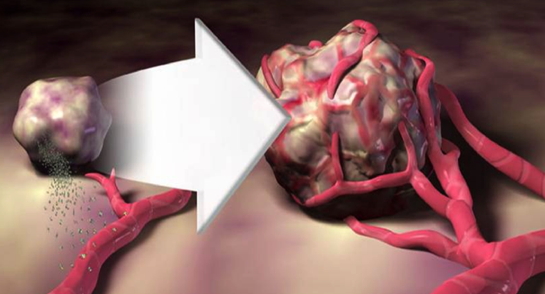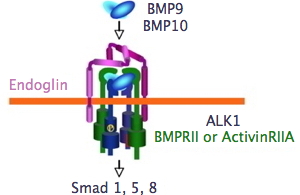 Team leader
Team leader
|
Sabine Bailly
Laboratory of Biology and Biotechnologies for Health
CEA-Grenoble
17 avenue des Martyrs
38 054 Grenoble cedex 9
Phone: 04 38 78 92 14
Fax: 04 38 78 50 58 |
 Members of the team
Members of the team
Valentin Azemard, IE INSERM
Sabine Bailly, DR1 INSERM
Léa Beurier-Soulat, Licence-pro
Claire Bouvard, MC UGA
Agnès Castan, IR1 INSERM
Nicolas Chaumontel, CEA Technician
Sophie Dupuis-Girod, MD, HCL Lyon
Nicolas Ricard, INSERM Researcher
Yasmin Rida, PhD Student
Florence Rivera, CEA Researcher
Aude Salomon, IE INSERM
Emmanuelle Tillet, UGA Prof.
Léa Vialet, PhD Student
| |

|
Tumoral angiogenesis | |
BMP9/BMP10/ALK1 signaling |
| | |

| |

|
 Introduction
Introduction Angiogenesis and lymphangiogenesis, which correspond to the formation of new blood and lymphatic vessels from existing vessels, are two major processes involved in physiological development, but also in tumoral development and metastatic dissemination. Since now ten years, anti-angiogenic treatments have been developed in order to asphyxiate the tumour or to inhibit metastasis but the results so far are not as promising as we thought. The understanding of how these new vessels are formed is thus very important for the development of new therapeutic approaches.
To address this question, our team is working since 2002 on a new signalling pathway specific to the vascular system mediated by the transmembranous receptor ALK1 (
activin receptor-like kinase 1). ALK1 is a serine/threonine kinase type 1 receptor of the TGFß family that is specifically expressed on endothelial cells. Several studies obtained in man and mouse support its critical role in vascular development:
- Mutations in the gene encoding ALK1 (ACVRL1) are associated to two vascular rare defects:
- The Rendu-Osler (RO) disease, also known as hereditary haemorrhagic telangiectasia (HHT2)
(Johnson
et al.,1996)). HHT is characterized by telangiectasia, epistaxis (nose bleed) and arterio-venous shunts in the liver, the lungs and the brain that can lead to death in the more severe cases. Mutations in endoglin, a co-receptor for ALK1 are also responsible of another form of HHT (HHT1). The clinical signs are very similar to HHT2 supporting the key role of this signalling pathway for vascular integrity.
- The pulmonary arterial hypertension (PAH) (Harrison
et al.,2003). PAH is characterized by a progressive obliteration of the pulmonary arteries leading to hypertension and right heart failure.
- The inactivation of the gene encoding
Alk1 in mice leads to embryonic lethality (E11.5) due to severe vascular defects (Oh
et al.,2000 ; Urness
et al.,2000).
 ProjectsThe aim of the team is to continue the study of the involvement of ALK1 and its ligands, BMP9 and BMP10 in blood and lymphatic vascular development in order to propose new therapeutic approaches in vascular diseases and cancer. For this, we are developing the following axes of research:
ProjectsThe aim of the team is to continue the study of the involvement of ALK1 and its ligands, BMP9 and BMP10 in blood and lymphatic vascular development in order to propose new therapeutic approaches in vascular diseases and cancer. For this, we are developing the following axes of research:
1) Study of the respective roles of BMP9 and BMP10 in blood and lymphatic development
2) Study on the involvement of BMP9 and BMP10 in the two vascular diseases involving ALK1:
- hereditary haemorrhagic telangiectasia (HHT)/Rendu-Osler disease
- Pulmonary arterial hypertension (PAH)
3) Study of the involvement of BMP9 and BMP10 in cancer and metastasis: ALK1 as a therapeutic target. Keywords
Keywords Angiogenesis, Lymphangiogenesis, BMP and TGFß signaling, HHT, PAH, Cancer
 International collaboration: TGFß and Chagas disease
International collaboration: TGFß and Chagas disease
Since 2000, our team collaborates with a Brazilian team at the Fiocruz (Dr. TC de Araújo-Jorge, Rio de Janeiro, Brazil) on the involvement of TGFß in Chagas disease. Chagas disease results from the infection of the parasite
Trypanosoma cruzi that will lead to myocardiopathy. This collaboration has demonstrated that TGFß influences the development of this pathology through regulation of parasite invasion into the heart, intracellular parasite cycle, inflammation and immune response, heart fibrosis remodelling and heart conductance. We have shown that inhibitors of the TGFß signalling pathway, used both
in vitro and
in vivo, reduce parasite invasion, heart fibrosis and increase survival in mice models (Waghabi
et al.,2007 ; Araujo-Jorge
et al.,2008 ; Waghabi
et al.,2009 ; de Oliviera
et al.,2012 ; Araujo-Jorge
et al.,2012).
 Selected highlights of the team
Selected highlights of the team Publications of the team
Publications of the team Defended theses in the team
Defended theses in the team